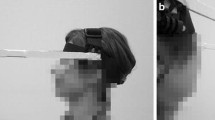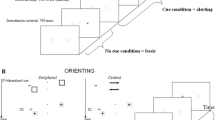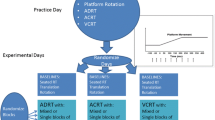Abstract
In many situations successful execution of a balance-recovery reaction requires visual information about the environment. In particular, reactions that involve rapid limb movements, such as stepping, must be controlled to avoid obstacles and accommodate other constraints on limb trajectory. However, it is unknown whether the central nervous system can acquire the necessary visuospatial information prior to perturbation onset or must, instead, redirect gaze at the floor during the execution of the stepping reaction. To study this we examined gaze behaviour, during rapid forward-directed stepping reactions triggered by unpredictable platform perturbation, in 12 healthy young adults. We also monitored switching of attention, as inferred from onset of significant error in performing a concurrent visuomotor tracking task. Obstacles and/or step targets were used as constraints, to increase demands for accurate foot movement. Downward gaze shifts towards the floor almost never occurred during stepping reactions when foot motion was unconstrained but did occur more frequently as the demands for accurate foot movement increased. Nonetheless, even in the most challenging condition (target plus obstacle), downward redirection of gaze occurred in less than 40% of the trials, and subjects were commonly well able to clear the obstacle and land the foot on the target without redirecting their gaze towards the floor. An apparent switching of attention, subsequent to perturbation onset, occurred frequently (>80% of trials) in all task conditions, independent of the gaze shifts. The findings indicate that visual fixation of the foot or floor was not essential for accurate control of the foot movement, nor was the apparent switching of attention that followed perturbation onset linked, in any consistent way, to overt changes in visual fixation. Spatial features of the support surface were apparently “remembered” prior to perturbation onset, thereby allowing both vision and attention to be directed to other demands during the execution of the balance reaction.





Similar content being viewed by others
References
Abrams RA (1992) Coordination of eye and hand for aimed limb movements. In: Proteau L, Elliot D (eds) Vision and motor control. Elsevier, Amsterdam, pp 129–152
Brandt TH, Dichgans J, Koenig E (1973) Differential effects of central versus peripheral vision on egocentric and exocentric motion perception. Exp Brain Res 16:476–491
Brauer SG, Woollacott M, Shumway-Cook A (2002) The influence of a concurrent cognitive task on the compensatory stepping response to a perturbation in balance-impaired and healthy elders. Gait Posture 15:83–93
Chou LS, Draganich LF, Song SM (1997) Minimum energy trajectories of the swing ankle when stepping over obstacles of different heights. J Biomech 30:115–120
Colby CL (1998) Action-oriented spatial reference frames in cortex. Neuron 20:15–24
Di Fabio RP, Zampieri C, Greany JF (2003) Aging and saccade-stepping interactions in humans. Neurosci Lett 339:179–182
Diener HC, Dichgans J, Guschlbauer B, Bacher M (1986) Role of visual and static vestibular influences on dynamic postural control. Hum Neurobiol 5:105–113
Ghafouri M, McIlroy WE, Maki BE (2004) Initiation of rapid reach-and-grasp balance reactions: is a pre-formed visuospatial map used in controlling the initial arm trajectory? Exp Brain Res 155:532–536
Harris LR, Jenkin M (2001) Vision and attention. In: Jenkin M, Harris LR (eds) Vision and attention. Springer, Berlin Heidelberg New York, pp 2–17
Hollands MA, Marple-Horvat DE (1996) Visually guided stepping under conditions of step cycle-related denial of visual information. Exp Brain Res 109:343–356
Hollands MA, Marple-Horvat DE (2001) Coordination of eye and leg movements during visually guided stepping. J Mot Behav 33:205–216
Hollands MA, Marple-Horvat DE, Henkes S, Rowan AK (1995) Human eye movements during visually guided stepping. J Mot Behav 27:155–163
Hsiao ET, Robinovitch SN (1999) Biomechanical influences on balance recovery by stepping. J Biomech 32:1099–1106
Hunter MC, Hoffman MA (2001) Postural control: visual and cognitive manipulations. Gait Posture 13:41–48
Lyon D (1990) Large and rapid improvement in form discrimination accuracy following a location precue. Acta Psychol 73:69–82
Maki BE, McIlroy WE (1997) The role of limb movements in maintaining upright stance: the “change-in-support” strategy. Phys Ther 77:488–507
Maki BE, McIlroy WE (1999) The control of foot placement during compensatory stepping reactions: does speed of response take precedence over stability?. IEEE Trans Rehabil Eng 7:80–90
Maki BE, Norrie RG, Zecevic A, Quant S, Kirshenbaum N, Bateni H, McIlroy WE (2001a) Initiation and execution of rapid postural reactions and stepping movements: which phases require visuospatial attention? In: Duysens J, Smits-Engelsman BCM, Kingma H (eds) Control of posture and gait. International Society for Postural and Gait Research, Maastricht, The Netherlands, pp 573–576
Maki BE, Zecevic A, Bateni H, Kirshenbaum N, McIlroy WE (2001b) Cognitive demands of executing rapid postural reactions: does aging impede attentional switching? NeuroReport 12:3583–3587
Maki BE, McIlroy WE, Fernie GR (2003) Change-in-support reactions for balance recovery: control mechanisms, age-related changes and implications for fall prevention. IEEE Eng Med Biol Mag 22:20–26
McFadden S, Wallman J (2001) Shifts of attention and saccades are very similar: are they causally linked?. In: Jenkin M, Harris LR (eds) Vision and attention. Springer, Berlin Heidelberg New York, pp 19–39
McIlroy WE, Maki BE (1995) Early activation of arm muscles follows external perturbations of upright stance. Neurosci Lett 184:177–180
McIlroy WE, Maki BE (1997) Preferred placement of the feet during quiet stance: development of a standardized foot placement for balance testing. Clin Biomech 12:66–70
McIlroy WE, Norrie RG, Brooke JD, Bishop DC, Nelson AJ, Maki BE (1999) Temporal properties of attention sharing consequent to disturbed balance. NeuroReport 10:2895–2899
Norrie RG, Maki BE, Staines WR, McIlroy WE (2002) The time course of attention shifts following perturbation of upright stance. Exp Brain Res 146:315–321
Pai YC (2003) Movement termination and stability in standing. Exerc Sports Sci Rev 31:19–25
Patla AE, Vickers JN (1997) Where and when do we look as we approach and step over an obstacle in the travel path? NeuroReport 8:3661–3665
Quant S, Adkin A, Staines WR, Maki BE, McIlroy WE (2004) The effect of a concurrent cognitive task on cortical potentials evoked by unpredictable balance perturbations. Biomed Cent Neurosci 5:18
Rankin J, Woollacott MH, Shumway-Cook A, Brown L (2000) Cognitive influence on postural stability: a neuromuscular analysis in young and elders. J Gerontol 55A:M112–M119
Redfern MS, Jennings JR, Martin C, Furman JM (2001) Attention influences sensory integration for postural control in older adults. Gait Posture 14:211–216
Redfern MS, Muller ML, Jennings JR, Furman JM (2002) Attentional dynamics in postural control during perturbations in young and older adults. J Gerontol 57:B298–B303
Shumway-Cook A, Woollacott M (2000) Attentional demands and postural control: the effect of sensory context. J Gerontol 55A:M10–M16
Zettel JL, McIlroy WE, Maki BE (2002a) Can stabilizing features of rapid triggered stepping reactions be modulated to meet environmental constraints? Exp Brain Res 145:297–308
Zettel JL, McIlroy WE, Maki BE (2002b) Environmental constraints on foot trajectory reveal the capacity for modulation of anticipatory postural adjustments during rapid triggered stepping reactions. Exp Brain Res 146:38–47
Acknowledgments
This study was supported by grants from the Canadian Institutes of Health Research (CIHR) and the Ontario Neurotrauma Foundation. B.E.M. was a CIHR Senior Investigator and W.E.M. held a Canada Research Chair in neuro-rehabilitation. J.L.Z. held scholarships from the Natural Sciences and Engineering Research Council and from the Health Care, Technology and Place Program (University of Toronto).
Author information
Authors and Affiliations
Corresponding author
Additional information
Presented (in part) at the 16th International Symposium on Posture and Gait (Sydney, Australia; March 2003), the 13th Biennial Conference of the Canadian Society for Biomechanics (Halifax, Canada; August 2004), and the 34th Annual Meeting of the Society for Neuroscience (San Diego, California; October 2004).
Rights and permissions
About this article
Cite this article
Zettel, J.L., Holbeche, A., McIlroy, W.E. et al. Redirection of gaze and switching of attention during rapid stepping reactions evoked by unpredictable postural perturbation. Exp Brain Res 165, 392–401 (2005). https://doi.org/10.1007/s00221-005-2310-1
Received:
Accepted:
Published:
Issue Date:
DOI: https://doi.org/10.1007/s00221-005-2310-1




